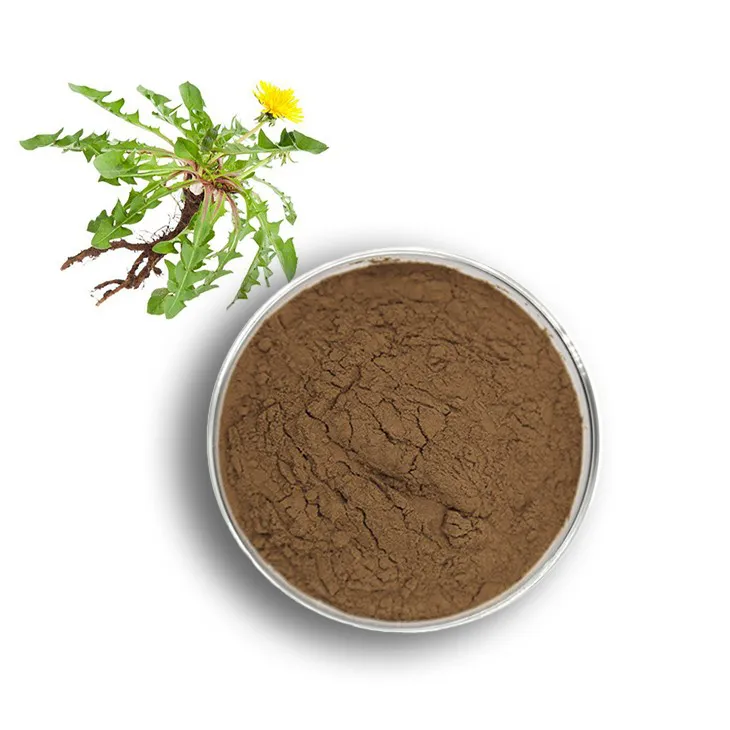- 0086-571-85302990
- sales@greenskybio.com
The best dandelion root extract in nature.
2024-11-29

1. Introduction to Dandelion and Its Root
The dandelion (Taraxacum officinale) is a common and well - known plant that can be found in many parts of the world. It is often regarded as a weed in lawns and gardens, but in fact, it is a plant with a wealth of valuable properties.
The dandelion root is a crucial part of the plant. It is long, slender, and tap - like in shape. The root system is quite complex and can penetrate deep into the soil, which helps the plant to access nutrients and water efficiently. The root is rich in various bioactive compounds, which form the basis for the extraction of Dandelion Root Extract.

2. Obtaining Dandelion Root Extract
2.1 Harvesting
The first step in obtaining Dandelion Root Extract is the proper harvesting of the dandelion roots. This is typically done in the spring or fall when the plant is in a suitable growth stage. Harvesters need to be careful not to damage the roots during the extraction process. They are often dug out using small tools like trowels or forks.
2.2 Cleaning
Once harvested, the roots are thoroughly cleaned to remove any soil, debris, or other impurities. This can be done by gently washing them with water. Clean roots are essential to ensure the purity of the final extract.
2.3 Drying
After cleaning, the roots are dried. This can be achieved through natural drying in a well - ventilated area or by using drying equipment at a low temperature. Proper drying helps to preserve the active ingredients in the roots.
2.4 Extraction Process
There are several methods for extracting the valuable compounds from the dried dandelion roots. One common method is solvent extraction, where solvents such as ethanol or water are used to dissolve the active ingredients. Another method is supercritical fluid extraction, which can be more precise in isolating specific compounds. The choice of extraction method can affect the quality and composition of the final dandelion root extract.
3. Health Applications of Dandelion Root Extract
3.1 Promoting Healthy Skin
Dandelion root extract is rich in nutrients such as vitamins (including vitamin A, C, and E), minerals (such as potassium and zinc), and antioxidants. These components play important roles in promoting healthy skin. For example, vitamin A is essential for skin cell renewal, vitamin C helps in collagen synthesis, and antioxidants protect the skin from free - radical damage. Regular use of products containing dandelion root extract may result in a more radiant and youthful - looking skin.
3.2 Aiding in Kidney Function
The diuretic properties of dandelion root extract make it beneficial for kidney function. It helps to increase urine production, which in turn can assist in flushing out toxins and waste products from the body. This can be particularly helpful for people with mild kidney problems or those who want to support their overall renal health.
3.3 Digestive Health
Dandelion root extract can also have a positive impact on digestive health. It stimulates the production of bile, which is important for the digestion and absorption of fats. Additionally, it may help to relieve digestive discomfort such as bloating and indigestion. Some studies suggest that it can act as a mild laxative, promoting regular bowel movements.
3.4 Immune System Support
The antioxidants and other bioactive compounds in dandelion root extract can contribute to a strengthened immune system. By protecting the body's cells from oxidative stress and supporting the function of immune cells, it may help the body to better defend against infections and diseases. Incorporating dandelion root extract into one's diet or supplement routine may be a natural way to boost immunity.
4. Environmental Factors Affecting the Quality of the Extract
4.1 Soil Quality
The quality of the soil in which the dandelion grows has a significant impact on the quality of the root and, consequently, the extract. Soil rich in organic matter, with proper pH levels and nutrient availability, will produce dandelion roots with higher concentrations of active ingredients. For example, soil with a slightly acidic pH may enhance the uptake of certain minerals by the dandelion roots.
4.2 Climate and Location
The climate and location where the dandelion is grown also matter. Dandelions grown in areas with ample sunlight and appropriate rainfall tend to be healthier and have more robust root systems. Mountainous regions or areas with clean air may also produce dandelions with higher - quality roots, as they are less exposed to pollutants.
4.3 Pesticide and Chemical Exposure
Exposure to pesticides and other chemicals can have a negative impact on the quality of dandelion root extract. Dandelions growing in areas treated with pesticides may absorb these harmful substances, which can then be present in the extract. Therefore, it is important to source dandelions from areas that are free from pesticide use or are organically grown.5. Latest Research Findings on Dandelion Root Extract
Recent research on dandelion root extract has uncovered some interesting findings. For example, some studies have shown that certain compounds in the extract may have anti - cancer properties. These compounds may be able to inhibit the growth of cancer cells or induce apoptosis (programmed cell death) in vitro and in some animal models. However, more research is needed to fully understand the potential of dandelion root extract in cancer treatment.
Another area of research is focused on its anti - inflammatory effects. Dandelion root extract has been found to reduce inflammation in certain tissues, which may be beneficial for conditions such as arthritis or inflammatory bowel disease. The mechanisms underlying these anti - inflammatory effects are still being investigated, but it is believed that the antioxidants and other bioactive compounds in the extract play a role.
Furthermore, research has also explored the potential of dandelion root extract in managing diabetes. Some studies suggest that it may help to regulate blood sugar levels by improving insulin sensitivity or affecting glucose metabolism in the body. However, again, more in - vivo and human - based studies are required to confirm these effects.
6. Future Potential in the Field of Natural Health
The future potential of dandelion root extract in the field of natural health is quite promising. As consumers become more interested in natural and plant - based remedies, dandelion root extract is likely to gain more popularity. It has the potential to be incorporated into a wide range of products, such as skincare products, dietary supplements, and functional foods.
With further research, it may also find new applications in the treatment of various diseases. For example, if the anti - cancer properties are further validated, it could be developed into a complementary or alternative treatment option. The development of more efficient extraction methods and standardization of the extract's composition will also contribute to its wider acceptance and use in the medical and health fields.
However, there are also challenges to be addressed. Ensuring the quality and safety of dandelion root extract, especially in the face of increasing commercial production, will be crucial. Additionally, more research is needed to fully understand its long - term effects and potential interactions with other medications or substances.
FAQ:
How is dandelion root extract obtained?
The dandelion root extract is typically obtained through a process that involves harvesting the dandelion plants, carefully cleaning the roots, and then using extraction methods such as solvent extraction or steam distillation to draw out the beneficial compounds from the roots.
What are the nutrients in dandelion root extract that promote healthy skin?
Dandelion root extract contains vitamins like vitamin A, C, and E, as well as minerals such as potassium and zinc. These nutrients play important roles in maintaining skin health. Vitamin A helps with skin cell turnover, vitamin C is an antioxidant that protects the skin from damage, and the minerals contribute to overall skin function.
How does dandelion root extract aid in kidney function?
Dandelion root extract has diuretic properties. It helps increase the production of urine, which can assist in flushing out toxins and waste products from the kidneys. Additionally, it may help regulate the balance of fluids and electrolytes in the body, which is crucial for proper kidney function.
What environmental factors affect the quality of dandelion root extract?
The quality of dandelion root extract can be affected by several environmental factors. Soil quality is important, as a nutrient - rich soil can lead to more potent plants. The amount of sunlight and water the dandelions receive also matters. Pesticide use in the area where the dandelions grow can potentially contaminate the plants and affect the quality of the extract. Also, air pollution can have an impact on the overall health and quality of the dandelion plants from which the extract is made.
What are the latest research findings on dandelion root extract?
Recent research has shown that dandelion root extract may have anti - cancer properties. Some studies have indicated that it can induce apoptosis (cell death) in cancer cells. There is also ongoing research into its potential anti - inflammatory effects and its role in managing diabetes. Additionally, new research is exploring how dandelion root extract may interact with the gut microbiome to promote overall health.
Related literature
- Title: The Health Benefits of Dandelion Root Extract: A Comprehensive Review"
- Title: "Dandelion Root Extract: From Traditional Use to Modern Research"
- Title: "Environmental Impact on the Quality of Dandelion - Based Extracts"
- ▶ Hesperidin
- ▶ citrus bioflavonoids
- ▶ plant extract
- ▶ lycopene
- ▶ Diosmin
- ▶ Grape seed extract
- ▶ Sea buckthorn Juice Powder
- ▶ Beetroot powder
- ▶ Hops Extract
- ▶ Artichoke Extract
- ▶ Reishi mushroom extract
- ▶ Astaxanthin
- ▶ Green Tea Extract
- ▶ Curcumin Extract
- ▶ Horse Chestnut Extract
- ▶ Other Problems
- ▶ Boswellia Serrata Extract
- ▶ Resveratrol Extract
- ▶ Marigold Extract
- ▶ Grape Leaf Extract
- ▶ blog3
- ▶ Aminolevulinic acid
- ▶ Cranberry Extract
-
The best lemon juice powder in nature.
2024-11-29
-
Organic Vitamin K2 Powder Suppliers
2024-11-29
-
Bulk purchase of L - tyrosine.
2024-11-29
-
Vitamin K2 Manufacturers
2024-11-29
-
Passionflower Extract
2024-11-29
-
Maitake Mushroom Extract
2024-11-29
-
Cocoa Extract
2024-11-29
-
Polygonum Cuspidatum Extract
2024-11-29
-
Black Rice Extract
2024-11-29
-
Mango flavored powder
2024-11-29
-
Shikone Extract
2024-11-29
-
Angelica sinensis extract
2024-11-29
-
Ginseng Root Extract
2024-11-29
-
Aminolevulinic acid
2024-11-29























